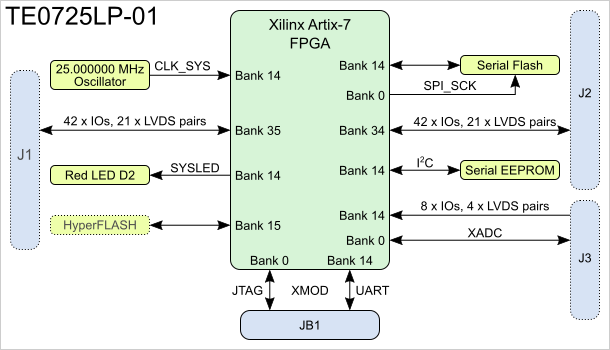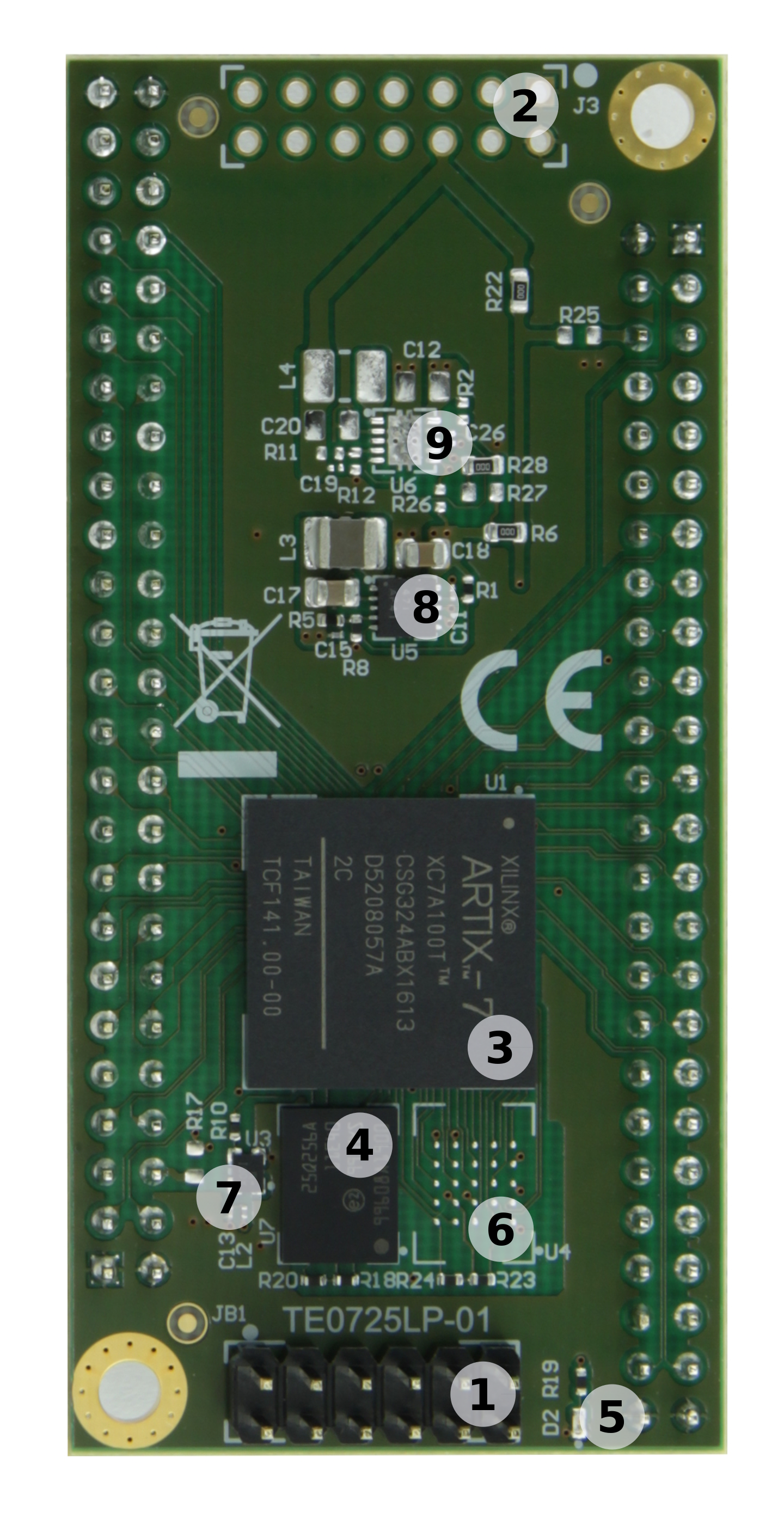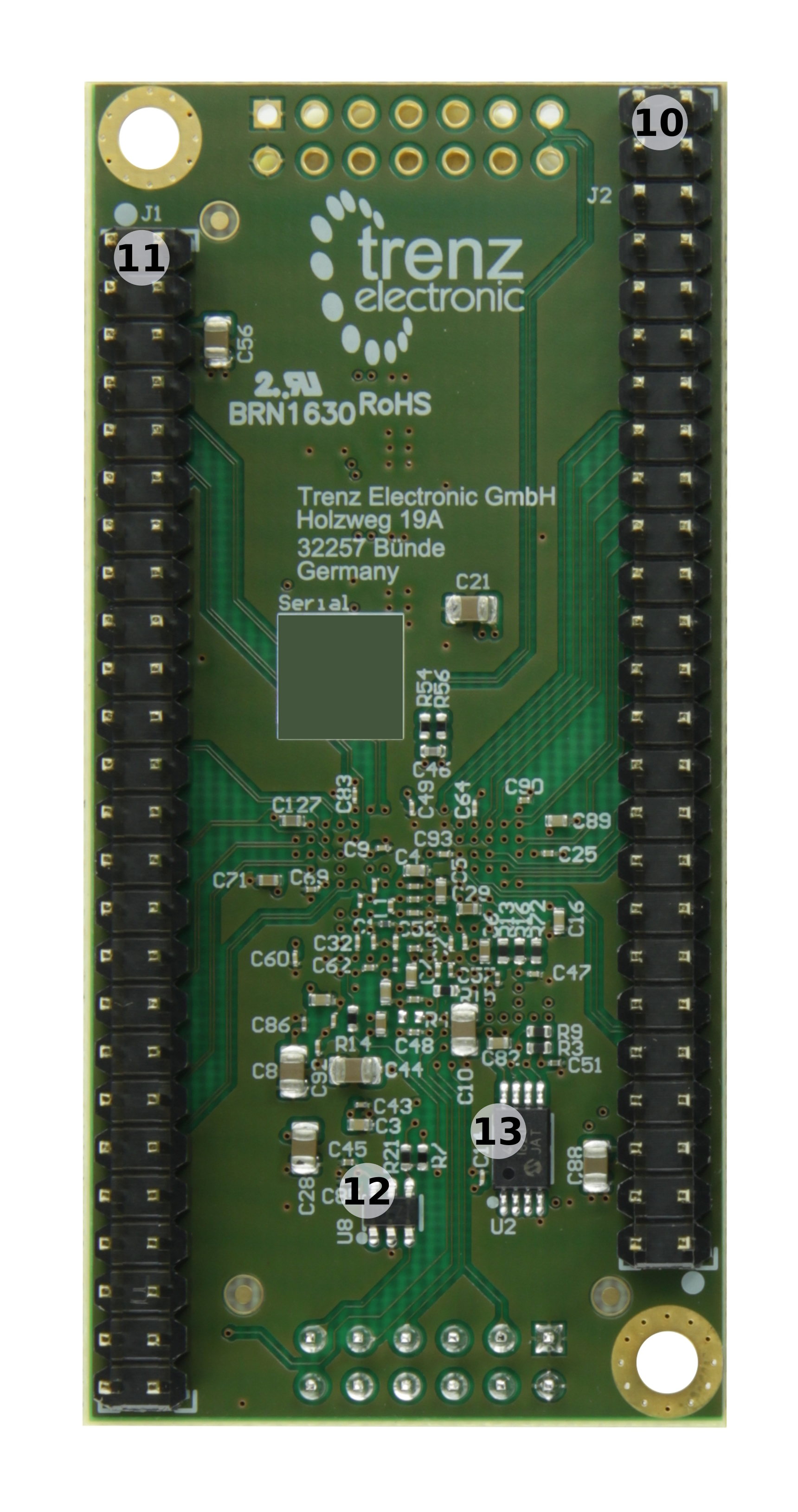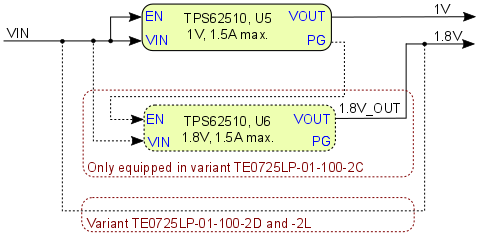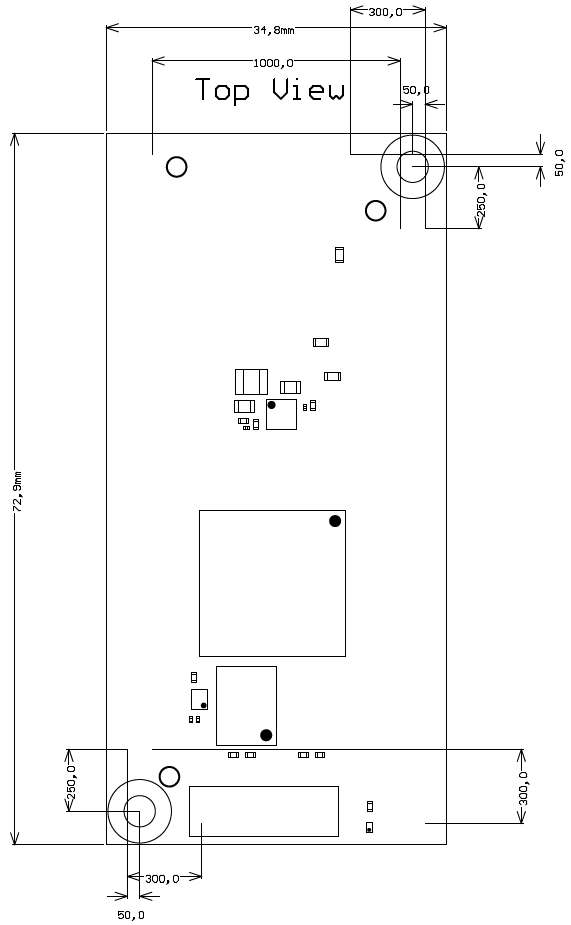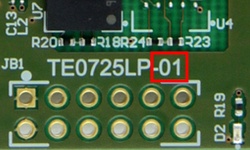Page History
...
| HTML |
|---|
<!-- Template Revision 1.663 (HTML comment will not display, it's not needed to remove them. For Template/Skeleton changes, increase Template Revision number. So we can check faster, if the TRM style is up to date) --> |
| Scroll Ignore |
|---|
Download PDF version of this document. |
| Scroll pdf ignore | |
|---|---|
Table of Contents
|
Overview
The Trenz Electronic TE0725LP is a low cost small-sized FPGA module integrating a Xilinx Artix-7 and 32 MByte Flash memory for configuration and operation.
| Scroll Only (inline) |
|---|
Refer to |
...
http:// |
...
trenz |
...
. |
...
org/te0725LP-info for online version of this manual and the rest of available documentation of the product. |
...
|
Key Features
Xilinx Artix-7 XC7A100T Commercial temperature grade (Industrial on Request)FPGA
32 MByte QSPI Flash memory
2 x 50-pin headers with 2,54mm pitch, ideal for breadboard use
- 92 IOs x GPIOs (42 + 42 + 8)
- 25.000000 MHz system clock
- 128 KBit (16 KByte) I2C EEPROM
3.3V single power supply with on-board voltage regulators
JTAG/UART connector
1 user LED
- Optional HyperRAM (8 to 32 MByte)
- Commercial temperature grade (Industrial on Request)
- Size 73 x 35 mm
Block Diagram
page
-breakFigure 1: TE0725LP-01 Block Diagram.
Main Components
Note on the images below, that there is no POF transceiver, no 50-pin headers and no JTAG/UART header installed.
Figure 2: TE0725LP-01 FPGA module (Variant TE0725LP-01-100-2D depicted).
- XMOD header, JB1
- 14-pin header placeholder for connector, J3
- Xilinx Artix-7 FPGA, U1
- 1.8V, 256 MBit (32 - MByte Flash ) quad SPI serial flash memory, U7
- Red LED (SYSLED), D2
- Cypress S26KS512S 512 MBit (64 MByte) 1.8V HyperFlash™ memory, U4 (optional)
- Low-power programmable oscillator @25.000000 MHz, U3
- Low VIN high-efficiency step-down converter (1.5A max.), U5
- Low VIN high-efficiency step-down converter , U6POF transceiver placeholder, U8(1.5A max.), U6 (optional)
- 50-pin header placeholder for breadboard connector, J1J2
- 50-pin header placeholder for breadboard connector, J2
- JTAG/UART connector, JB1
- Red LED (SYSLED), D2
- 16K x 8 (128-Kbit) serial EEPROM, U2
- Low-noise, high PSRR, RF, 200-mA low-dropout linear regulator, U9J1
- Ultra-low supply-current voltage monitor with optional watchdog, U6Cypress S27KS0641 64-Mbit (8-MByte) HyperRAM™ self-refresh DRAM, U4, U8
- 128KBit I2C CMOS serial EEPROM, U2
| Scroll Pagebreak |
|---|
Initial Delivery State
| On-board Programmable Device | Content | Notes |
|---|---|---|
| Quad SPI Flash (U7) OTP area | Empty | - |
| I2C EEPROM, U2 | Empty | - |
| HyperFlash™ memory, U4 | Empty | - |
Table 1: Module initial delivery state of programmable on-board devices.
Boot Process
By default the configuration mode pins of the FPGA are set to Master SPI mode, hence the FPGA is configured from serial QSPI flash memory at system start-up. The JTAG interface of the module is provided for storing the initial FPGA configuration data to the QSPI flash memory.
Signals, Interfaces and Pins
I/Os on Pin Headers
I/O signals of the FPGA SoC's I/O banks connected to the board's pin headers:
| Bank | Type | Pin Header | I/O Signal Count | Bank Voltage |
|---|---|---|---|---|
| 14 | HR | J3 | 8 I/O's, 4 LVDS pairs | 1.8V |
| 34 | HR | J2 | 42 I/Os, 21 LVDS pairs | VCCIO34 |
| 35 | HR | J1 | 42 I/Os, 21 LVDS pairs | VCCIO35 |
Table 2: General overview of single ended and LVDS I/O signals connected to pin headers
PL I/O-Banks
| Bank | VCCIOB2B | Used I/O's | Available On Connectors | Notes | ||||
|---|---|---|---|---|---|---|---|---|
| 0 | 31.3V8V | 7 | 0 | 4 | 4 I/O's used for JTAG interface, 3 control signals (DONE, PROG_B, INIT).JTAG | |||
| 14 | 3.3V | 0 (3) | 1.8V | 22 | 11 | 8 I/O's (4 LVDS pairs) connected to J3, 3 I/O in XMOD-JTAG - for use as UART's to XMOD header JB1 (2 UART I/O's, 1 user I/O), 1 I/O to LED D2. | ||
| 15 | 1.8V | 18 | 0- | used Used for optional hyper RAM | 16 | 2.5V | 0 | used for optional optical fiber transceiverHyperFlash™ U4. |
| 34 | User select | 42 | 42 | 0R 0-Ohm resistor R17 option to select 3.3V1.8V I/O-bank VCCIO. | ||||
| 35 | User select | 42 | 42 | 0R 0-Ohm resistor R25 option to select 1.8V I/O-bank VCCIO. |
Table 3
...
: General overview of PL I/O-bank signals.
JTAG Interface
JTAG access to the Xilinx Artix-7 device is provided through connector XMOD header JB1.
...
Header Connector JB1 (2 x 6 pin header) is compatible with XMOD-JTAG adapter TE0790. This adapter can be inserted from top onto the TE0725LP, if JB1 is fitted with male pin header. Optionally JB1 can be fitted with pin header from bottom, in that case the JTAG cable connector must be on the base board.When using
XMOD FTDI JTAG-Adapter Header JB1
The JTAG interface of the FPGA can be accessed via XMOD header JB1, so in JB1 then additionally USB UART is usable, and the push-button on XMOD works as configuration reset.
When using XMOD-JTAG please check the switch settings on XMOD to be sure the power and I/O reference are supplied correctly. TE0790 can be in some cases used to power up TE0725LP, however this is not recommended. TE0790-01 can not supply enough power for TE0725LP (LED may blink but the module is not operating properly, especially in case of larger and more sophisticated designs).
On-board LED's
...
use with the XMOD-FT2232H adapter-board TE0790 the FPGA can be configured via USB2.0 interface. The TE0790 board provides also an UART interface to the FPGA device which can be accessed by the USB2.0 interface of the adapter-board while the signals between these serial interfaces will be converted.
Following table describes the signals and interfaces of the XMOD header JB1:
| Pin Schematic Name | XMOD Header JB1 Pin | Note |
|---|---|---|
| F_TCK | C (pin J3-4) | - |
| F_TDO | D (pin J3-8) | - |
| F_TDI | F (pin J3-10) | - |
| F_TMS | H (pin J3-12) | - |
| UART_RXD | A (pin J3-3) | UART receive line, connected to PL I/O-bank 14. |
| UART_TXD | B (pin J3-7) | UART transmit line, connected to PL I/O-bank 14. |
| XMOD_E | E (pin J3-9) | User configurable, connected to PL I/O-bank 14, pin M17. |
| NRST | G (pin J3-11) | Assigned to 'PROG_B' (configuration-reset signal of FPGA) via IC U8. |
Table 4: XMOD header JX1 signals and connections.
When using XMOD FTDI JTAG Adapter TE0790, the adapter-board's VCCIO will be sourced by the FPGA module's supply voltage (1.8V). The adapter board's VCC has to be sourced by the USB Host interface.
For this configuration, set the XMOD DIP-switch as follows in table below:
| XMOD DIP-switches | Position |
|---|---|
| Switch 1 | ON |
| Switch 2 | OFF |
| Switch 3 | OFF |
| Switch 4 | ON |
Table 5: XMOD adapter board DIP-switch positions for voltage configuration.
| Note |
|---|
Use Xilinx compatible TE0790 adapter board (designation TE-0790-xx with out 'L') to program the Xilinx Zynq devices. The TE0790 adapter board's CPLD have to be configured with the Standard variant of the firmware. Refer to the TE0790 Resources Site for further information and firmware download. |
UART Interface
UART interface is available on B2B connector JM2. With the TE0790 XMOD USB2.0 adapter, the UART signals can be converted to USB2.0 interface signals:
| UART Signal Schematic Name | B2B | XMOD Header JX1 | Pin Header J3 | Note |
|---|---|---|---|---|
| B14_L0 | JM2-99 | JX1-7 | J3-7 | UART-TX (transmit line) |
| B14_L25 | JM2-97 | JX1-3 | J3-3 | UART-RX (receive line) |
Table 6: UART interface signals.
QSPI Interface
The QSPI interface of the FPGA device is routed to and used by the on-module QSPI flash IC U7:
| SD IO Signal Schematic Name | FPGA I/O | Flash Memory (U7) Pin | Note |
|---|---|---|---|
| SPI-DQO | Bank 14, pin K17 | D3 | QSPI data |
| SPI-DQ1 | Bank 14, pin K18 | D2 | QSPI data |
| SPI-DQ2 | Bank 14, pin L14 | C4 | QSPI data |
| SPI-DQ3 | Bank 14, pin M14 | D4 | QSPI data |
| SPI_SCK | Bank 0, pin E9 | B2 | QSPI clock |
| SPI-CS | Bank 14, pin L13 | C2 | QSPI chip select |
Table 7: QSPI interface signals.
I2C Interface
The I2C interface of the FPGA device is routed to and used by the on-module EEPROM IC U2:
| I²C Signal Schematic Name | FPGA I/O | EEPROM (U2) Pin | Notes |
|---|---|---|---|
| I2C_SDA | Bank 14, pin U18 | 5 | I²C data line, 1.8V reference voltage |
| I2C_SCL | Bank 14, pin U17 | 6 | I²C clock line, 1.8V reference voltage |
| I2C_WP | Bank 14, pin T18 | 7 | Write-protect signal of EEPROM |
Table 8: I2C interface signals.
Differential Analog Input
The TE0725LP FPGA module provides access to the XADC (Analog-to-Digital Converter) unit of the Xilinx FPGA via connector J3:
| I²C Signal Schematic Name | FPGA I/O | Connector J3 Pin | Notes |
|---|---|---|---|
| XADC_P | Bank 0, pin J10 (VP_0) | J3-14 | - |
| XADC_N | Bank 0, pin K9 (VN_0) | J3-13 | - |
Table 9: XADC interface signals.
On-board Peripherals
Quad SPI Flash Memory
On-module QSPI flash memory (U7) is provided by Micron Serial NOR Flash Memory N25Q256A with 256 MBit (32 MByte) storage capacity. This non volatile memory is used to store initial FPGA configuration. Besides FPGA configuration, remaining free flash memory can be used for user application and data storage. All four SPI data lines are connected to the FPGA allowing x1, x2 or x4 data bus widths. Maximum data rate depends on the selected bus width and clock frequency used.
HyperFlash™ Memory
On the TE0725LP FPGA module is optionally available a Cypress S26KS512S 512 MBit (64 MByte) 1.8V HyperFlash™ memory IC (U4). This flash memory IC is connected to the FPGA bank 15 via the Cypress specific HyperBus interface, which offers read bandwidth up to 333MByte/s.
EEPROM
A Microchip 24AA128 128 KBit (16 KByte) CMOS Serial EEPROM (U2). The device is organized as eight blocks of 16 KBit memory with a 2-wire serial interface connected on FPGA bank 14. The memory as is available for application use. It is accessible over I2C bus with slave device address 0x50.
System Clock Oscillator
A low-power SiTime programmable oscillator (U3) @25.000000 MHz configured on-module is connected to PL I/O-bank 14 and provides the system reference clock signal.
On-board LEDs
There is one red LED connected to the FPGA bank 14, pin M16. This LED is user configurable to indicate for example any system status.
| LED | Color | Signal Schematic Name | FPGA | Notes |
|---|---|---|---|---|
| D2 | Red | 'SYSLED' | Pin M16 | - |
Table 10: LEDs of the module.
Connectors
All connectors are are for 100mil headers, all connector locations are in 100 mil grid.
...
100mil (2.54mm) grid. The module's PCB provides footprints to mount and solder optional (B2B connector) headers, if those are not factory-fitted on module.
Power and Power-On Sequence
To power-up a module, power supply with minimum current capability of 1A is recommended.
Power Supply
TE0725LP needs one single power supply with nominal of 3.3V at the variant TE0725-01-100-2C or 1.8V at the variants TE0725LP-01-100-2D and TE0725LP-01-100-2L. Following diagram shows the dependencies of the power supply:
Figure 3: Module power supply dependencies
Power Consumption
| FPGA | Design | Typical Power, 25C ambient |
|---|---|---|
| A100TXC7A100T-2CSG324C | Not configured | TBD* |
Table 11: Module power consumption
*TBD - To Be Determined.
Actual power consumption depends on the FPGA design and ambient temperature.
Power-On Sequence
There is no specific or special power-on sequence, single power source is needed as VIN, rest of the sequence is automatic.
Variants Currently In Production
...
FPGA Chip Model
...
VIN Supply Voltage
...
.
Voltage Monitor Circuit
The 1.8V voltage level is monitored by the voltage monitor circuit U8, which generates the PROG_B signal to begin a new configuration sequence after reset of the FPGA. A manual reset is also possible by driving the connector pin JB1-11 ('NRST') to GND. Hence, by this pin a mounted XMOD adapter board can perform a reset on the FPGA module.
Figure 4: Voltage monitor circuit
Power Rails
Power Rail Name | J1 Pins | J2 Pins | J3 Pins | JB1 Pin | Direction | Notes |
|---|---|---|---|---|---|---|
| VIN | 5 | 5 | 5 | - | Input | Power supply voltage |
| 1.8V | - | - | - | 6 | Output | JTAG VCCIO |
| 1.8V_OUT | - | - | - | 6 | Output | - |
| VCCIO34 | - | 6, 45 | - | - | Input | Bank voltage |
| VCCIO35 | 6, 45 | - | - | - | Input | Bank voltage |
Table 13: Board power rails
Bank Voltages
Bank | Bank I/O Voltage VCCO | Voltage Range |
|---|---|---|
| 0 (config) | 1.8V | fixed |
| 14 (HR) | 1.8V | fixed |
| 15 (HR) | 1.8V | fixed |
| 34 (HR) | VCCIO34 | 1.2V ... 3.3V |
| 35 (HR) | VCCIO35 | 1.2V ... 3.3V |
Table 14: Board bank voltages
Variants Currently In Production
| HTML |
|---|
<!--
Set correct link to the overview table of the product on english and german, if not available, set
https://shop.trenz-electronic.de/de/Produkte/Trenz-Electronic/
https://shop.trenz-electronic.de/en/Products/Trenz-Electronic/
--> |
| Trenz shop TE0725LP overview page | |
|---|---|
| English page | German page |
...
Table 12: Module variants production
Technical Specifications
Absolute Maximum Ratings
Parameter | Min | Max | Units | Reference document |
|---|---|---|---|---|
VIN supply voltage (Variant TE0725LP-01-100-2C) |
-0.3 | 4 | V | TI TPS62510 data sheet |
| VIN supply voltage (Variant TE0725LP-01-100-2D and -2L) | -0. |
| 3 |
| 2 | V |
| Xilinx datasheet DS181 / TI TPS62510 datasheet | ||||
| HR I/O banks supply voltage (VCCO) | -0.5 | 3.6 | V | Xilinx datasheet DS181 |
| HR I/O banks input voltage (VCCIO single ended) | -0.4 | VCCO + 0.55 | V | Xilinx datasheet DS181 |
Storage Temperature | -40 | + |
100 | °C | LED SML-P11x series datasheet |
Table 13: Absolute maximum ratings
Recommended Operating Conditions
| Parameter | Min | Max | Units | Reference document |
|---|---|---|---|---|
| VIN supply voltage |
| (Variant TE0725LP-01-100-2C) | 1.8 | 3.8 | V | TI TPS62510 data sheet |
| VIN supply voltage (Variant TE0725LP-01-100-2D and -2L) | 1.8 | 1.89 | V | Xilinx datasheet DS181 / TI TPS62510 datasheet |
| HR I/O banks supply voltage (VCCO) | 1.14 | 3.465 | V | Xilinx datasheet DS181 |
| HR I/O banks input voltage (VCCIO single ended) | -0.20 | VCCO + 0.20 | V | Xilinx datasheet DS181 |
| Operating Temperature | 0 | +85 | °C |
| Xilinx datasheet DS181 |
Table 14: Recommended operating conditions
| Note |
|---|
| Please check Xilinx datasheet datasheet DS181 for complete list of absolute maximum and recommended operating ratings for the Artix-7 device. |
| Page break |
|---|
Physical Dimensions
Please note that two different units are used on the figures below, SI system millimeters (mm) and imperial system thousandths of an inch(mil). This is because of the 100mil pin headers used, see also explanation below. To convert mils to millimeters and vice versa use formula 100mil's = 2,54mm.
Board size: PCB 72.9mm × 34.
...
8mm
PCB thickness: ca. 1.65mm
Highest part on the PCB are the pin headers (2.54mm pitch). Please download the step model for exact numbers.
The dimensions are given in mm and mil (milli inch).
Figure 5: Module physical dimensions drawing
All 100 mil pin headers are in 100 mil grid, the M3 mounting holes are in 50 mil grid aligned to the centers of the 100mil headers. The module is symmetrical, turning it 180 degrees will keep all I/O and Power pins in both 50 pin headers in compatible places.
| Page break |
|---|
Operating Temperature Ranges
Commercial grade modules
All parts conform to at least commercial temperature range of 0°C to +70°C.
Industrial grade modules
All parts are at least industrial temperature range of -40°C to +85°C.
The module operating temperature range depends on customer design and cooling solution. Please contact us for options.
Weight
8.5 g Plain module.
Revision History
Hardware Revision History
Table 15: Module hardware revision history
Hardware revision number is printed on the PCB board together with the module model number separated by the dash.
Figure 6: Module hardware revision number
Document Change History
| Date | Revision | Contributors | Description | 2017-08-17 | Jan Kumann | Initial version.||||||||||||||||||||
|---|---|---|---|---|---|---|---|---|---|---|---|---|---|---|---|---|---|---|---|---|---|---|---|---|---|
|
|
|
| ||||||||||||||||||||||
| v.45 | Ali Naseri, Jan Kumann |
|
Table 16: Document change history
Disclaimer
| Include Page | ||||
|---|---|---|---|---|
|
